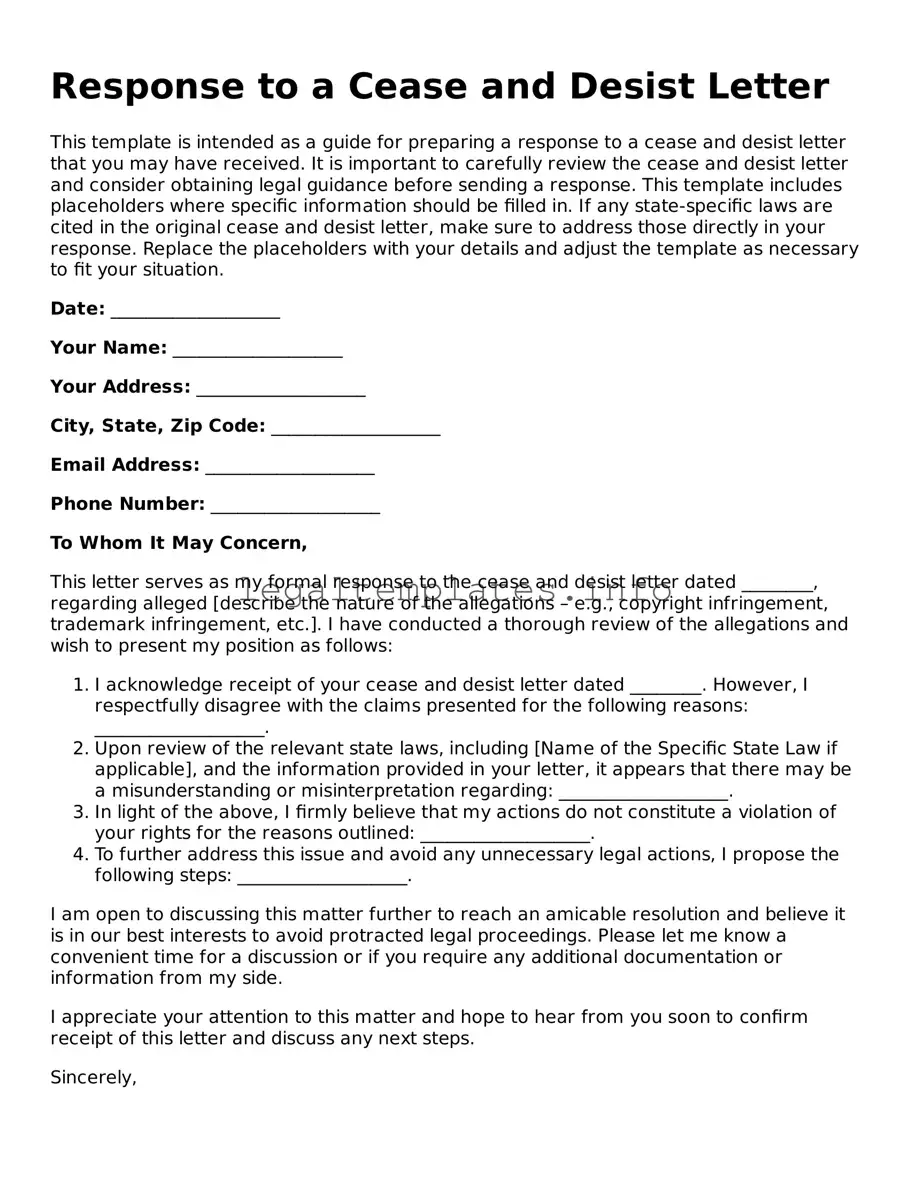What is a Response to a Cease and Desist Letter?
A Response to a Cease and Desist Letter is a formal written reply made by an individual or entity who has received a cease and desist letter. This letter demands the cessation of alleged illegal activities. The response can either agree to comply with the demands, offer a counter-argument to the claims made, or seek further clarification.
Why might someone need to respond to a Cease and Desist Letter?
Responding to a Cease and Desist Letter is necessary to address the allegations made against you or your organization. It serves as an opportunity to clarify misunderstandings, agree to discontinue the alleged wrongful activity, or defend your actions and assert your rights, possibly preventing further legal action.
What should be included in a Response to a Cease and Desist Letter?
A well-crafted response should include a clear reference to the cease and desist letter received, a detailed account or rebuttal of each allegation (if you are disputing the claims), any evidence supporting your position, and your demands or conditions for resolution. It's also important to maintain a professional tone throughout the letter.
How should one decide whether to comply, dispute, or seek more information in response to a Cease and Desist Letter?
Deciding on how to respond depends on the specifics of the cease and desist letter and your situation. If you believe the allegations are true and you've inadvertently infringed on someone's rights, complying might be the best course of action. If the claims are unfounded, you might choose to dispute them. If unclear about the details or extent of the allegations, seeking more information is a practical step.
Is it necessary to have a lawyer draft the Response to a Cease and Desist Letter?
While it’s not mandatory to enlist a lawyer, it’s highly recommended. A legal professional can provide valuable insight into the implications of the allegations against you, advise on the best course of action, and help draft a response that effectively communicates your stance while minimizing potential legal fallout.
Can ignoring a Cease and Desist Letter have legal consequences?
Ignoring a Cease and Desist Letter can lead to escalated legal action from the sender, including lawsuits. While the letter itself doesn't carry legal force, it can be used as evidence of your awareness of the alleged infringement should the matter go to court.
How soon should one respond to a Cease and Desist Letter?
It's advisable to respond promptly, usually within the time frame suggested in the cease and desist letter, if applicable. Delaying your response can be interpreted as ignoring the allegations, potentially leading to escalated legal action against you.
Can a response to a Cease and Desist Letter be sent via email?
While it’s possible to send your response via email, it’s often recommended to use certified mail with a return receipt requested. This method provides proof that your response was received, which could be important if the dispute escalates to legal proceedings.
Should a Response to a Cease and Desist Letter admit to any wrongdoing?
Without legal advice, admitting to any wrongdoing in your response could be detrimental. It’s crucial to consult with a legal professional before acknowledging any form of liability, as this could be used against you in legal proceedings.
